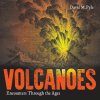By
Leon (NHBS Catalogue Editor)
7 Nov 2018
Written for Paperback

I will immediately admit that I have retained a boyish fascination with volcanoes. And, as
Volcanoes: Encounters Through the Ages shows, I am not alone. Written by volcanologist David M. Pyle to accompany a 2017 spring exhibition at the Bodleian Library in Oxford, this book brings together many historical illustrations from their collections to show how volcanoes have been represented and described over time, and how this has shaped our present understanding. I have not visited the Bodleian Library before, but this book makes me wish I had.
Pyle immediately points out that this is not a textbook (for that, see e.g.
Volcanoes), but even so, the introduction explains the basics of plate tectonics (see also my review of
The Tectonic Plates are Moving!) and how that creates hotspots of volcanic eruptions. After this, Pyle takes a look at the historical written record, acknowledging, but not further considering, that oral history might record even older eruptions (see my review of
The Edge of Memory).
By necessity, this book takes a look at the more representative examples of historical records of volcanic eruptions. Greek and Roman philosophers already described them, but the book leans heavily towards descriptions from the 1600s onwards. This includes eruptions of the Vesuvius and Etna volcanoes in Italy, but also the many volcanoes early explorers encountered around the world in Iceland, Southeast Asia, South America, and the Pacific. There are the volcanic islands that can rise above, and sometimes again disappear below the waves in a matter of weeks (notably the island of Surtsey that appeared off the coast of Iceland in 1963 and became an open laboratory to study how new land is colonised by plants and other life forms, see
Surtsey: Ecosystems Formed).
Other examples include historical eruptions around the 1900s in the Caribbean that caused much destruction on the islands of Montserrat and St. Vincent. And, of course, some of the largest eruptions in the last few hundred years are included, namely the well-documented eruptions of Krakatoa, Laki, and Tambora (each the subject of excellent books, see
Krakatoa,
Island on Fire, and
Tambora). Notably missing and only mentioned in passing are recent eruptions such as Pinatubo and Mount St. Helens (the latter is well represented in the literature though, see for example
In the Path of Destruction and
Eruption: The Untold Story of Mount St. Helens).
Pyle liberally quotes from eyewitness testimony of eruptions, and the ideas of early geologists and natural historians who were trying to understand how volcanoes worked. Some of their ideas were remarkably prescient and stand, sometimes little modified, to this day. Finally, he explores the continued difficulty of predicting eruptions, as well as the potentially devastating impact of the rare eruptions of supervolcanoes (for more on those, see also
Super Volcano,
Eruptions that Shook the World, and
When Humans Nearly Vanished)
The highlight of this book, though, are the numerous historical illustrations that were included in the exhibition and that are collected in this book. From woodcuts and paintings to old maps and the first photographs, this is a remarkable and beautiful collection. The reproduction is excellent, though some double-page spreads unfortunately end up hiding some of the details in their inner margins (this is something you see an awful lot in art and photo books and always makes me question how it is we still have not satisfactorily solved this). Other images are spread over one-and-a-half page, where this is less of a problem; illustrators naturally put the important things in the centre of their image.
Though it is by no means a comprehensive text, the unique collection of historical images makes
Volcanoes: Encounters Through the Ages a must for anyone interested in volcanoes. I expect that even seasoned readers in this subject will not have seen many of the wonderful illustrations that have been reproduced here. My only regret after reading this book is that I did not visit the exhibition when it was on.






































